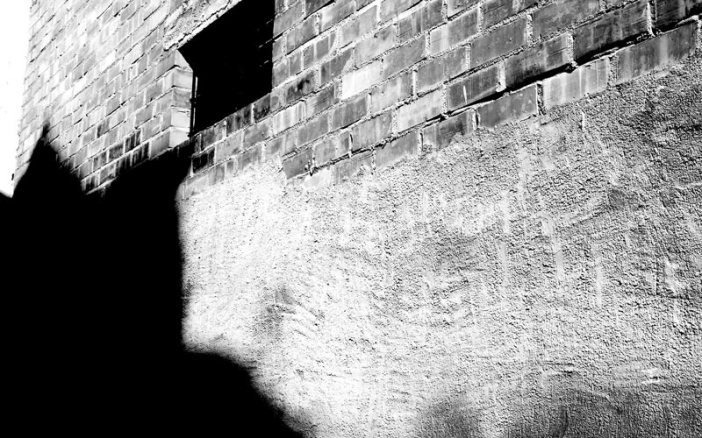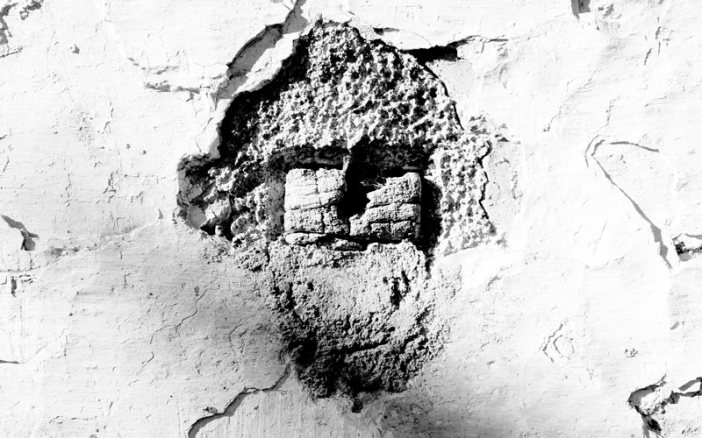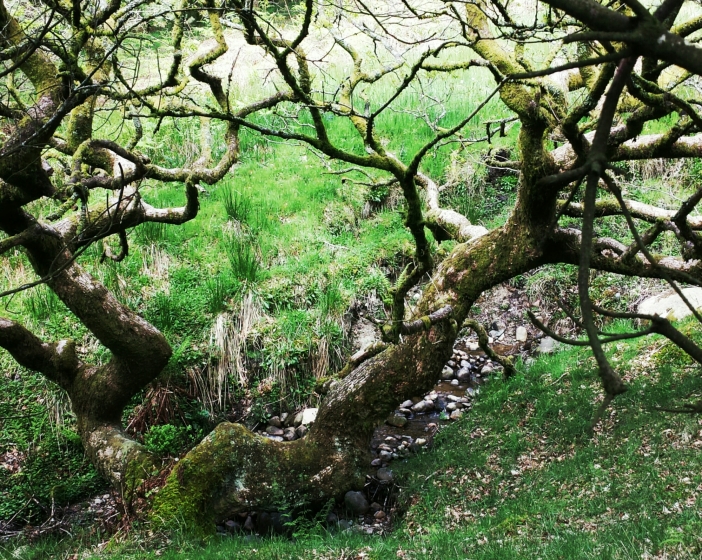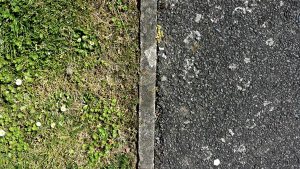
Notes for Visitors
In December 2016 deep-cover operatives affiliated with experimental art website The Unstitute were planted into the village of Tivenys, in the remote Catalonian countryside. Their brief was kept a secret, with communications restricted to a regular deposit of encrypted ‘.Zip’ archive files which could only be opened with decryption keys held at The Unstitute itself. Needless to say, the experiment being currently undertaken involves in some way an attempt to ‘decode’ the target location – a place as good as any other, I suppose – which is presumably to be later re-assembled piece by piece into a place known only as ‘New Town’; a labyrinthine, digitally constructed environment, accessible only online via the digital architectures of The Unstitute.
The first obstacle in the realisation of New Town is that it cannot be described or documented using conventional methods. Not only is the project entirely subjective – and necessarily so – but New Town itself also constitutes a partial reconstruction of the fictive, mistaken, transient or imagined elements which consciousness generates about any place in particular, and how these ‘maps’, formed in the mind and always operating on our perceptions, are subject to continual pressures of distortion from one source or the other, but are no less indispensable for being so. These maps are built from our exercise within the territory. It is these maps, intangibly conscious, which we in turn aim to map-out, to produce topographies of, to explore, or otherwise convey.
Artistic inquiries into daily life are used to penetrate the everyday quality of existence in this place – an effort which in part is used to help accept that the World cannot, should not and will not conform to the ideas we have about our experience of it, but no doubt such distortions do arise. It is no surprise then to find New Town only partially visible, inadequately described, exaggerated or poorly lit – much like a lonely street at night, or the dream of one; a report of nothing happening somewhere.
Bettany Unction
Chief Curator and Nihilist
1st March, 2017
Mental Architectures:
The Dynamic Environments of New Town

i) Grey Areas
In daily life, I orientate myself repeatedly using imagined spaces, or inferences; i.e. “I know logically there is a street adjacent to this one, though I’ve never seen it”, or “though it seems like there’s nothing over there, upon inspection actually there’s a whole bunch of particular things over there in that particular place”. Over a period, a huge topography of spaces is gathered but which are not fixed; instead always growing, adjusting, realigning, rebuilding according to our experience. Inside this twilit image of the world of which one is conscious, it is frequently necessary for the brain to ‘patch’ together generic blocks of visual data to represent places that you cannot directly see, but of which you know must exist through inference or hearsay, (i.e “the other side of that hill”, or “the other side of that house”,) mental images which will not be formed until one has a direct/repeated experience of the said place. These we denote as ‘grey areas’, and form the largest part of New Town; the areas beyond our direct access but of which we have pre-formed mental ideas about, and for which may or may not have a concrete reality for anybody else. For instance, a person may walk along a street on her way to work every day of the week for years and never particularly notice the specific details of all of the places along the way – it is indeed hard or impossible to really pay very close attention to the details of everything, and one might always find some building, shed or other part of the built environment that had never really quite existed for you up until right now, up to and including the changes which continually take place within a given area by the passing of Time. The effort to produce a topography or a temporal topography of these grey areas is an effort to look into the feeling of personal limitation and location, observing the evolving tapestry of mental constructions about places and the things in them, and to represent this complex, subtle awareness of grey areas within the global map under construction.

ii) Particular Places
The effort required in making such detailed topographical observations does however have its merits, and colours our mental maps correspondingly and may furthermore produce benefits for long-term adaptations to the mapping regime. So, in contrast to grey areas, these areas which have been explored – which are within our known domain – we shall call particular places. They are not permanent, perfect or real, for we are dealing with mental approximations and mutable figments, but these particular ones have suffered close scrutiny and the effect of undertaking such observations over extended periods is of great interest to us; both the effects on the place under observation and on the subject doing the observing. A high proportion of places – even ones in our most local proximity, i.e. our neighbour’s bedroom – are however consigned almost certainly to our personal oblivion, to remain vague, and most likely to never at all emerge from the abyss of the twilit world of generalised, generic, expedient pre-formed chunks of form built with the absence of experienced sense-data – although many of our enquiries operate on precisely this level, and New Town itself is very much constructed within such mental topographies. Our enquiry will not however cover the mental architectures of the other occupants of the town, for that would be too nebulous to include here, though a growing awareness of the private experience of others forms an interesting and vast set of unmapped terrains which are sublime to contemplate and observe, having both direct and indirect influences over ourselves and our own mental environment.

iii) Territory
Though we have spoken about the space in the imagination in which we construct models of ‘particular places’ and ‘grey areas’, we must inquire as to whether this process is a product of our territorial impulses, (i.e. the primary way in which we actively explore space,) and whether these mental spaces themselves are territorial. Everyone is territorial. As I engage in my territory, which is how I supply my mental topography with data, any experiences incurred within the territory have corresponding effects over my mental representations of them, and vice-versa. This dynamic makes the comprehension of space in terms of the details mapped therein is not however for the purpose of recording absolutely everything in the highest resolution, or with terribly great accuracy or even the pretense of objectivity – these are the concerns of Nasa or Google. We may obsess over certain details in the landscape or built environment similar to the way in which a dog is furiously interested in the smell of a wall, engaged within a dynamic system of territorial behaviours – even to the degree that such activities as may be required in public or private might have a correspondingly significant effect on our practice, and furthermore, on the construction of New Town. Or, through a process of exploring the edges of territory – at frontiers, sometimes patrolling them, sometimes crossing them, other times not – we may produce an additional layer of sense about our inner and outer environs and thus evolve our conscious experience.
The New Town project is territorial, inasmuch as territory is defined as a dynamic set of fluctuating boundaries – both physical and otherwise – through which frequent deterritorializations are made. Being ‘territorial’ is hardly a choice – it is such a deep rooted mode of behaviour we actually cannot choose to be without it, and thus considerations of territoriality are, literally, fundamental in the exploration of space. Attempts to accurately convey a sense of space without consideration for the feelings over which the experience of territory becomes territory, miss their mark – one feels territory in behaviours, the apprehension of boundaries, property or the physical presence. If one feels afraid to continue, or feels likely to be arrested or even seen, one might turn back. The process of evolution records territorial behaviours so deeply in the architecture of our currently available consciousness that it operates, extremely effectively, at the basic level of primordial gut feelings, and without a sense of these, the viewer of a map or some other record of a place will only see the physical definitions of property and its boundary lines. By employing artistic means to weave thorough inquiry together with a very close examination of feeling, the construction of New Town out of its respective blocks must always incorporate in one way or another the particular set of feelings associated with particular places – which is what makes them particular in the first instance – and how those feelings modify our inexorably territorial behaviour.
The peculiar forms of mapping or topographical procedures undertaken by the operatives within the target area (Tivenys) and the re-construction of that material into a digital place (New Town) opens questions as to the nature of the inquiry; does New Town produce new territories and/or territorial possibilities within the Internet, and if so, is the aim to undermine the utopianism of the Internet? Or perhaps there is an effort to create and cultivate some corner of it – a ‘walled garden’ of sorts? Certainly, there is a world-building fantasy at play, yet one not only conscious, but entirely dependent upon its limits. To create a digital reality as deep and as rich as the physical place itself, and escape to it – or perhaps, escape through it? The architecture of utopia encounters the architecture of escape, the architecture of the boundary, the architecture of defense. Architecture – as a function of territory. Mental architectures as consciousness of territory. Consciousness as Territory. Would Utopia be – Territorial? All the more need for back-doors, emergency exits and short-cuts of all kinds…

iv) The Wilderness
At the periphery of New Town exists the haze of what remains unknown or undocumented. Within the territory of this virtual environment there is an edge of the world; in this sense it shares something with a videogame environment, presumably at the edge of which there is nowhere further to go – the horizon you see is effectively a painted backdrop. Or perhaps it echoes the ancient Norse sentiment of the world’s end, or the pre-Copernican post-Trumpian flat earth-ers. Howsoever construed, the territory mapped constitutes the known horizon of New Town; beyond this lies The Wilderness, the grey-area, the unknown and enveloping ignorance beyond the horizon, (the mapping of which is so nebulous cannot but be related to the topic of Entropy, introduced below.) The Wilderness is an undefined, vague area which makes frequent incursions into the environment of New Town, and threatens the town as its primary antagonist. Indeed, the vastness of this undocumented terrain is one particular hazard associated with The Wilderness; the generalisations about its contents – the painted backdrop of ‘grey areas’ – constitutes another. The effects of these areas on the territories of New Town are a case in point.

v) Entropy
The particular type of topography exercised in the creation of New Town would certainly miss a dimension if it did not reveal the effects of Entropy upon these mental architectures, and that such activities performed gathering materials in the territory forms part of the entropic processes revealed in the whole. This activity is certainly not limited to the physical decay in the built environment, of which there is much, or the ratio of derelict houses to occupied ones. My whole activity, at some times, could be said to be a complete waste of time. Or perhaps it will take forever to really get the right level of detail, and even then there would be infinitely more I could do? But waste is the way of all things, as they say, and thus the study of entropy within the global map forms a highly desirable dimension of the project of New Town, especially given the contradiction of a ‘new town’ within the one-way dynamics of an entropic system. Everything tends towards decay, so how should a new town remain new? New Town as – a Ship of Theseus? The logic involved in the study of waste is always one of exploring the inexorable movement of everything useful on its journey to becoming useless, drifting through the territories and landscapes of New Town, towards its rendezvous with the dust. We aim to construct a unique digital environment in which millions of micro-dramas – the passage of a piece of fluff out of a doorway, for instance – make their inexorable passage into digital consciousness in the territories of New Town.

vi) Language (Llenguatge)
“The way in which we speak of a place is as much of a place itself. Where we speak is who we speak.”
Proverb
Our experience of place becomes something different when it is shared – but also when it cannot be. A significant factor in the New Town project is the Catalan language, which we personally must encourage our tongues and thoughts to mimic, or remain on an island of English speech. Tivenys (pronounced Tibenz) is situated in the Iberian Peninsula of Catalonia – a disputed autonomous territory of Spain. The regional language here is Català – a vulgar Latin variant which shares much with Spanish, Italian and French. After General Franco tried to eliminate the Catalonian tongue during his fascist regime and replace it with Castilian Spanish, Catalans have fiercely maintained their own language and its dialects, and this territoriality of the tongue is a salient theme of New Town. Although the history of this particular language is fascinating in itself, (especially when immersed in it every day,) to pinpoint precisely the function of language in New Town would again benefit less from encyclopedic understanding than it would from first reactions. What is the sound of speech? What feeling is provoked through the encounter with an unintelligible call? How does the tongue react when imprisoned by the teeth, when humbled by a necessary, yet faltering response, alienated by habituation in another linguistic territory? Which hybrids are produced by an admixture of languages and attitudes to adaptation? These microscopic and subjective experiences are the beginning point for our investigation into the deterritorialized tongue, the possible functions of speech and the mouth in general, the sense generated by encounters with mundane narrative and chance interaction within the environments of New Town.
Written by Jim Broadband
Tivenys, Spain
March, 2017
Help spread the word on your own social media:











 (2011-2014)
(2011-2014) We dig tunnels.
We dig tunnels.
















You must be logged in to post a comment.